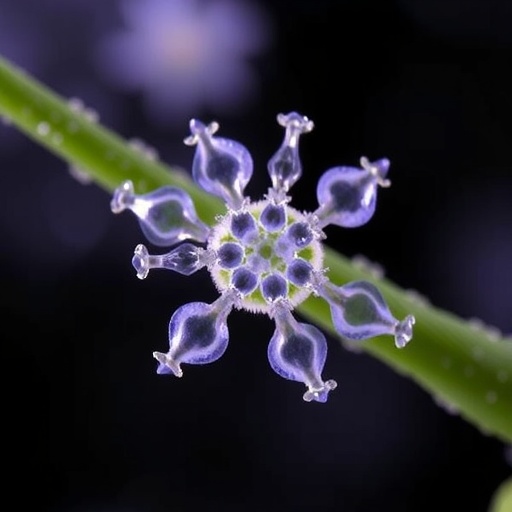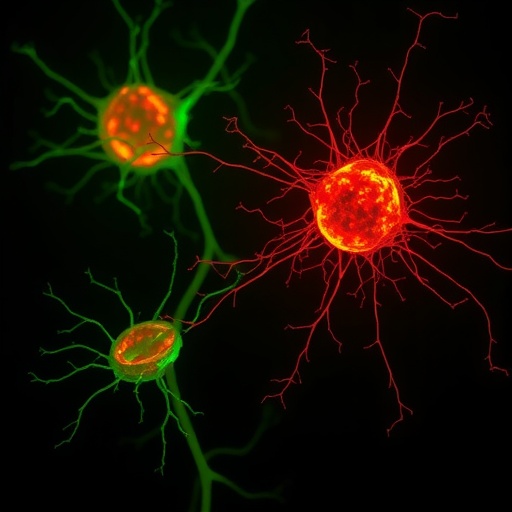In a remarkable advancement at the crossroads of biotechnology and robotics, researchers at the University of North Carolina have engineered microscopic soft robots resembling flowers, which can intricately alter their shape and behavior in response to environmental stimuli. These “DNA flowers” are extraordinarily dynamic structures, fabricated from specialized crystals formed by integrating DNA strands with inorganic materials. Their ability to reversibly fold and unfold within seconds designates them as some of the most versatile and responsive materials ever synthesized at such a minuscule scale, opening new avenues in the field of adaptive materials and nano-robotics.
At the heart of these DNA-based microbots is a sophisticated biochemical programmability. Each flower’s DNA is encoded with structural information that functions like a molecular computer program, orchestrating precise movements and reactions to external changes. When the surrounding biochemical environment shifts, particularly with fluctuations in acidity or pH, the DNA components respond by contracting or relaxing. This dynamic folding mechanism enables the flowers to open, close, or excrete chemical agents, mimicking the nuanced responses of living biological systems and paving the way for autonomous microscopic machines capable of complex tasks.
Dr. Ronit Freeman, the principal investigator and director of the Freeman Lab at UNC, highlights the transformative potential of this technology for medicine and beyond. She envisions applications such as ingestible or implantable capsules that use shape-shifting DNA flowers to deliver targeted therapeutics precisely when and where they are needed. The ability to activate medication upon detecting disease markers and cease function upon healing heralds a future where treatment is not only programmable but also intrinsically responsive, minimizing side effects and enhancing efficacy in ways conventional drug delivery methods simply cannot match.
The conceptual inspiration for this innovation stems from observing natural phenomena—how flowers unfurl their petals at dawn, coral polyps pulsate rhythmically, and tissues morph and grow in organisms. These biological processes involve complex, hierarchical self-assembly and responsiveness, which scientists have long attempted to replicate at micro and nanoscale. Capturing this complexity in synthetic materials has been a significant challenge due to limitations in material adaptability and responsiveness. However, the UNC team’s DNA-inorganic hybrid crystal platform ingeniously emulates these natural processes, integrating molecular recognition and mechanical actuation seamlessly.
The key to the flower’s metamorphosis lies in the precise arrangement and hierarchical structuring of the DNA within the crystal lattice. Under acidic conditions, which commonly characterize pathological environments such as tumors or inflamed tissues, certain DNA motifs fold tightly, resulting in the physical closure of the flower petals. This mechanical actuation is reversible; when the pH normalizes, the DNA unfolds, and the flower reopens. Such reversible conformational changes afford a programmable control mechanism that can modulate chemical reactions, cargo release, and even selective interaction with biological cells and tissues, thus functioning both as sensor and actuator at the nanoscale.
This reversible behavior is not only rapid but can be engineered with high specificity by designing DNA sequences responsive to desired chemical or physical triggers. The precise kinetic control over this folding and unfolding process means the DNA flowers can perform complex tasks autonomously without external intervention, a feature critical for practical deployment in biomedical or environmental settings. For instance, in a tumor microenvironment, the acidity-triggered closure could be exploited to release a payload of anticancer drugs directly at the tumor site while sparing healthy tissue, significantly reducing systemic toxicity.
The implications of these DNA flowers extend well beyond targeted drug delivery. In environmental science, these shape-responsive materials could revolutionize remediation strategies by releasing cleaning agents at polluted sites and subsequently breaking down harmlessly to avoid ecological impact. The ability of the DNA-inorganic framework to store and process molecular information also suggests applications in ultra-high-density data storage, where DNA’s innate information density could be harnessed to encode petabytes of data within minuscule volumes. These multifaceted utilities position DNA flowers as a versatile technological platform bridging living biological systems with engineered nanomachines.
From a materials science perspective, this research marks a paradigm shift in the design of metamaterials—engineered structures that derive unique properties from their organization rather than composition alone. The hierarchical assembly of DNA and inorganic crystals imparts not only mechanical flexibility but also biochemical reactivity, a combination rarely found in synthetic materials. This blend of properties enables the DNA flowers to operate at the interface between chemistry, biology, and robotics, effectively functioning as living materials capable of sensing, responding, and adapting autonomously in real time.
Despite being in early developmental stages, this technology demonstrates a profound leap towards realizing dynamic, shape-shifting materials inspired by natural morphogenesis. The rapid and reversible metamorphosis of these DNA-inorganic hybrids introduces new design principles for creating responsive nanostructures with programmable lifecycles and functions. Such materials may one day think, move, and adapt much like biological organisms, heralding an era where synthetic systems possess lifelike autonomy for applications spanning medicine, environmental management, and information technology.
Looking forward, the versatility of DNA-based structural programming and the possibility of integrating additional molecular components offer exciting prospects for creating even more multifunctional soft robots. By tuning the DNA sequences, inorganic composition, and environmental triggers, researchers could tailor the flowers to respond to a wider range of biological signals or perform multifaceted tasks, such as simultaneous sensing and delivery, environmental monitoring coupled with remediation, or dynamic interaction with living cells for regenerative medicine. This modular approach underlines a new frontier in material science where form and function are dictated by programmable molecular architecture.
In summary, UNC’s pioneering “DNA flower” soft robots exemplify an innovative leap in nanotechnology, combining molecular programming with structural metamorphosis to produce materials that not only mimic but also extend the capabilities of biological systems. These microscopic robots hold promise for transforming how medicine is delivered, environmental pollutants are treated, and data is stored, bringing science fiction’s vision of autonomous, intelligent materials closer to reality. As research progresses, these DNA-inorganic crystals could be foundational in developing the next generation of smart materials that seamlessly integrate sensing, actuation, and computation at the nanoscale.
Subject of Research: DNA-based microscopic soft robots with reversible shape-shifting capabilities
Article Title: Reversible Metamorphosis of Hierarchical DNA-Inorganic Crystals
News Publication Date: 20-Oct-2025
Web References: https://www.nature.com/articles/s41565-025-02026-8
References: DOI 10.1038/s41565-025-02026-8
Image Credits: Justin Hill, Philip Rosenberg, and Ronit Freeman
Keywords: Robotics, DNA, Biomimetics, Soft robotics
Tags: adaptive materials in biotechnologyautonomous microscopic machinesbiochemical programmability in materialsbiotechnology advancements at UNCchemical agent excretion mechanismsDNA-based microbots developmentenvironmental stimuli response in roboticsinnovative drug delivery technologiesmicroscopic DNA robotsprecision drug delivery systemsresponsive nano-roboticsstructural programming in DNA






